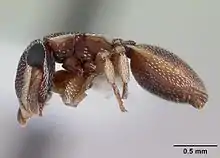Cephalotes maculatus
Cephalotes maculatus is a species of arboreal ant of the genus Cephalotes, characterized by an odd shaped head and the ability to "parachute" by steering their fall if they drop off of the tree they're on. Giving their name also as gliding ants.[1][2] The species is native across most of the South and Central America, from the Mexican state of Tamaulipas in the north, to the argentinian province of Tucumán in the south, making it one of the species with the largest native area in the genus Cephalotes[3] Their larger and flatter legs, a trait common with other members of the genus Cephalotes, gives them their gliding abilities.[4]
| Cephalotes maculatus | |
|---|---|
 | |
| Scientific classification | |
| Kingdom: | |
| Phylum: | |
| Class: | |
| Order: | |
| Suborder: | |
| Family: | |
| Subfamily: | |
| Genus: | |
| Species: | C. maculatus |
| Binomial name | |
| Cephalotes maculatus | |
The species was first given a description and a classification in 1876 by British entomologist Frederick Smith.
References
- Latreille, P.A. (1802). Histoire naturelle, generale et particuliere des crustaces et des insectes. Vol. 3. F. Dufart, Paris. 467 pp. PDF
- Yanoviak, S. P.; Munk, Y.; Dudley, R. (2011). "Evolution and Ecology of Directed Aerial Descent in Arboreal Ants" (PDF). Integrative and Comparative Biology. 51 (6): 944–956. doi:10.1093/icb/icr006. PMID 21562023.
- "Species Range Maps". Antmaps.org. Retrieved 25 January 2019.
- De Andrade, Maria; Urbani, Cesare (1999). Diversity and adaptation in the ant genus Cephalotes, past and present (Hymenoptera, Formicidae). Stuttgarter Beitraege zur Naturkunde Serie B (Geologie und Palaeontologie). pp. 378-381. Retrieved 25 January 2019.
This article is issued from Wikipedia. The text is licensed under Creative Commons - Attribution - Sharealike. Additional terms may apply for the media files.